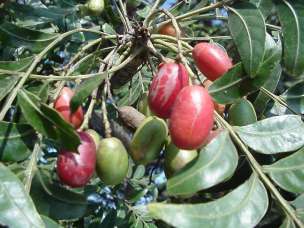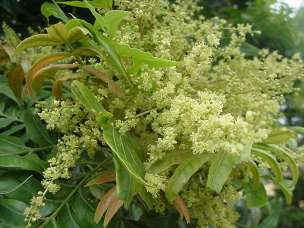Harpephyllum caffrum
Harpephyllum caffrum Bernh.
Family: Anacardiaceae
Common names: wild plum (Eng.); wildepruim, suurbessie, gwenjabessie (Afr.); umgwenya (Zulu, Xhosa); mothekele (Northern Sotho)
SA Tree No: 361
Introduction
This is an attractive evergreen tree that is useful as an ornamental garden tree and for attracting birds and butterflies into the garden.It is popularly planted as a street tree in a number of South African towns and cities. With its thick crown and somewhat drooping leaves,the wild plum is a good shade tree in the garden.

Description
Description
The wild plum is a large, evergreen tree that grows up to 15 m tall, and is usually found in riverine forests. The main stem is clean and straight, but the forest form often has supporting buttress roots. The bark is smooth when young, becoming rough, dark grey-brownas it grows older. Branches are curved bowed upwards, with leaves crowded towards the ends, forming a thick crown at the top of the tree.
The shiny dark green and glossy leaves are pinnate with sickle-shaped leaflets, and are sometimes interspersed with the odd red leaves.The whitish green flowers are borne near the ends of the branches with male and female flowers on separate trees, throughout summer (November to February). The tasty plum-like fruits first appear green and then turn red when they ripen in autumn; they contain a single seed and are enjoyed by people, mammals and birds.
The wild plum may be confused with the Cape ash (Ekebergia capensis) but is distinguishable by its sickle-shaped leaflets and the leaves that are crowded towards the end of the branches.
Distribution and habitat
Distribution description
The Harpephyllum caffrum grows from the Eastern Cape northwards through KwaZulu-Natal, Swaziland, southern Mozambique, Limpopo and into Zimbabwe. This is a popular tree in frost-free areas.
Derivation of name and historical aspects
History
The generic name Harpephyllum is of Greek derivation, meaning sickle-like leaves, referring to the shape of the falcate leaflets.The specific name caffrum is derived from its place of origin, Kaffraria, now part of Eastern Cape. This word also means 'indigenous'.
Harpephyllum caffrum belongs to the Anacardiaceae (mango family), which is the fourth largest tree family in southern Africa, boasting approximately 80 tree species and many shrubs. Commercially grown members of the family include mango (Mangifera indica), cashew nut (Anacardium occidentale), and pistachio nut (Pistacia vera). Locally, the fruit of wild plum and marula (Sclerocarya birrea) are well utilized and the latter is well commercialized. Some species that belong to this family are considered to be toxic, for example the rainbow leaf (Smodingium argutum).
Ecology
Ecology
Larvae of the common hairtail butterfly (Anthene definite) and the Eggar moth (Lasiocampa kollikerii) feed on leaves of this tree. Many animals including bushbabies, monkeys, baboons and bushbuck love the fruit of the wild plum. Birds such as Cape parrots, mousebirds, barbets, bulbuls, louries and African green pigeons and other fruit-eating birds feed on the fruits of this tree.
Uses
Use
The fruit of H. caffrum is edible and widely utilized by birds, animals, insects and humans. They are commonly used for making jams and jellies. With their sour taste, they are also good to make rosé wine. The tree has some potential as a commercial crop, but a preliminary trial planting in the Negev Desert in Israel was reported as disappointing.
The bark is a popular traditional medicine. It is used to treat acne and eczema, and is usually applied in the form of facial saunas and skin washes. It is used by people with 'bad blood' that results in pimples on the face. Powdered burnt bark is used to treat sprains and bone fractures. Bark is also used for dyeing, and it gives a mauve or pink colour. In some parts of Eastern Cape, root decoctions are traditionally taken for paralysis thought to have been contracted from walking over an area that has been poisoned or polluted through sorcery.
The wood of the H. caffrum is pale reddish and fairly heavy. It polishes well but is not very durable. It has been used as a general purpose timber, for furniture and beams. It is also used for carving curios.

Growing Harpephyllum caffrum
Grow
H. caffrum grows easily from seeds. Stored seeds should be soaked in water for a day and then be scrubbed with a brush to remove the fleshy part. It must then be sown in trays filled with river sand or a normal potting soil. They should not be planted too deep as they can easily rot. The seeds take 7 to 11 days to germinate.
The wild plum can also be propagated by means of cuttings and truncheons.The truncheons should be dried before planting; they can be left lying in the shade for a day or until all exudate has dried. The hole in which the truncheon is going to be planted should be filled with a layer of river sand to promote root formation and improve drainage. This also helps to combat fungal diseases.
References
- Coates Palgrave, M. 2002. Keith Coates Palgrave Trees of southern Africa, edn 3. Struik, Cape Town.
- Grant, R. & Thomas, V. 1998. Sappi tree spotting, KwaZulu-Natal Coast and Midlands. Jacana, Johannesburg.
- Hutchings, A., Scott, A.H., Lewis, G. & Cunnigham, A., 1996. Zulu medicinal plants:an inventory. University of Natal Press: Pietermaritzburg.
- Schmidt, E., Lötter, M. & McCleland, W. 2002. Trees and srubs of Mpumalanga and Kruger National Park. Jacana, Johannesburg.
- Van Wyk, B-E. & Gericke, N. 2000. People's plants. A guide to useful plants of southern Africa. Briza Publications, Pretoria.
- Van Wyk, B-E., Van Oudtshoorn, B. & Gericke, N. 1997. Medicinal plants of South Africa. Briza Publications, Pretoria.
- Venter, F. & Venter, J-A. 1996. Making the most of indigenous trees. Briza Publications, Pretoria. Mhlonishwa D. Dlamini Walter Sisulu National Botanical Garden September 2004
Credits
Mhlonishwa D. Dlamini
Walter Sisulu National Botanical Garden
September 2004
Plant Attributes:
Plant Type: Tree
SA Distribution: Eastern Cape, KwaZulu-Natal, Limpopo, Mpumalanga
Soil type: Sandy, Loam
Flowering season: Spring, Early Summer, Late Summer
PH: Neutral
Flower colour: Cream, Yellow
Aspect: Full Sun, Morning Sun (Semi Shade)
Gardening skill: Easy
Special Features:
Horticultural zones











Rate this article
Article well written and informative
Rate this plant
Is this an interesting plant?
Login to add your Comment
Back to topNot registered yet? Click here to register.